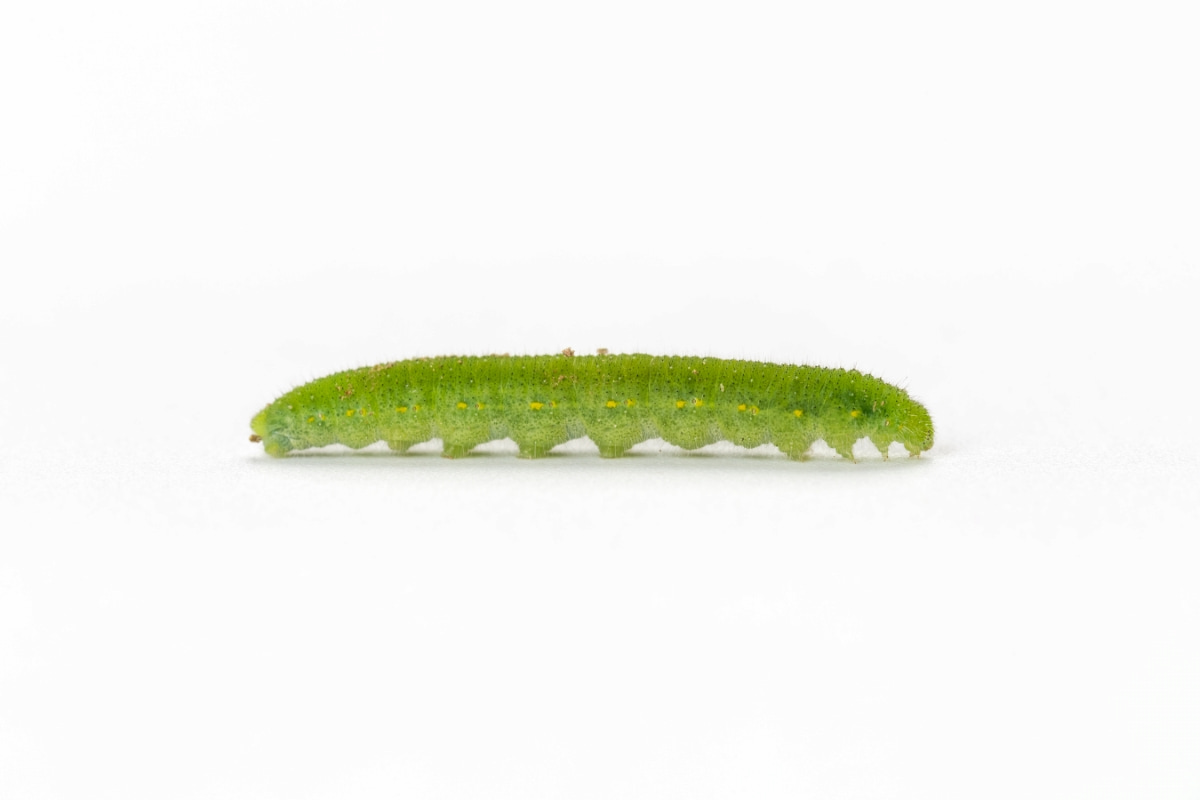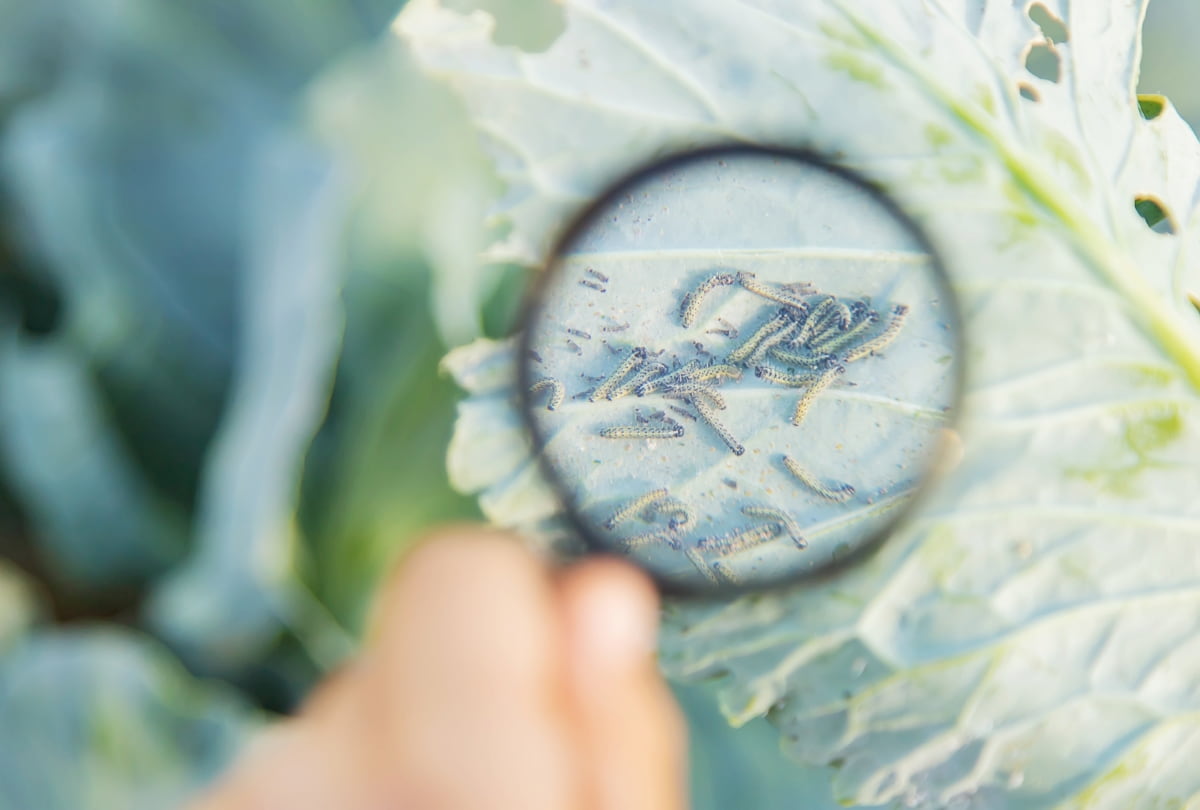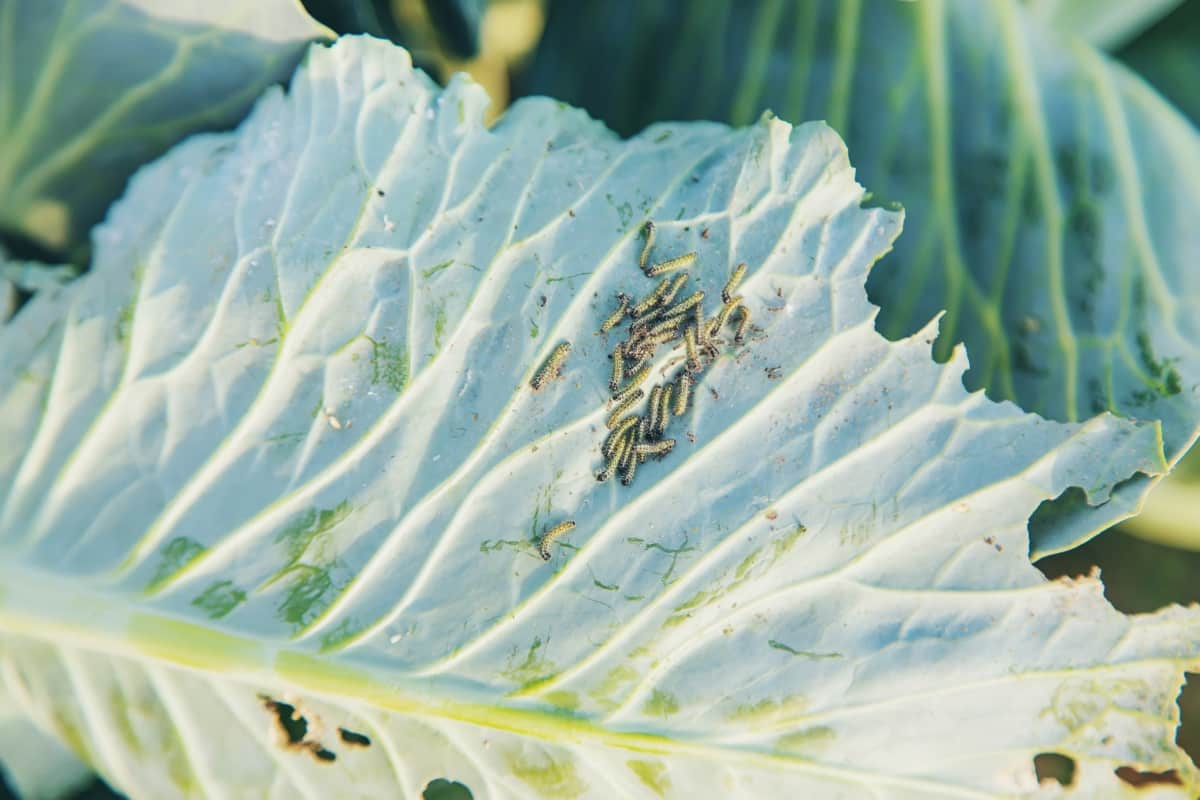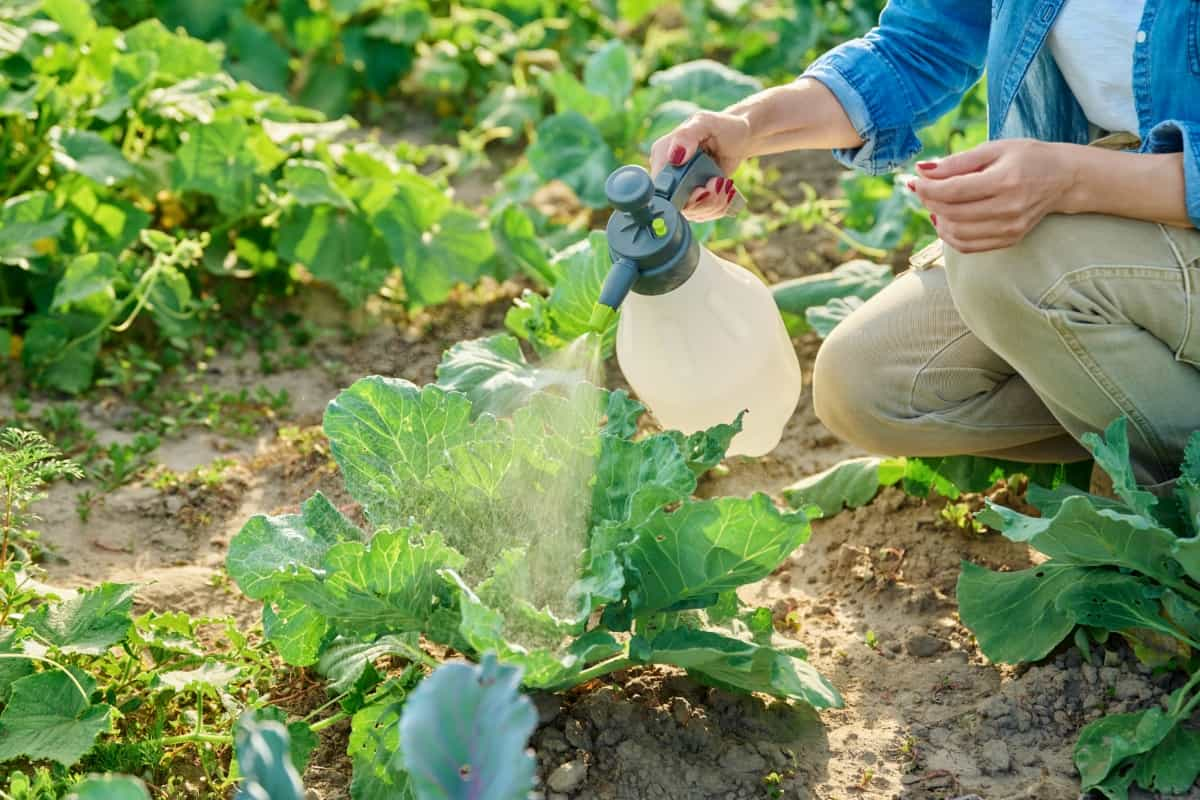Vegetable gardens must use a natural and organic method to control cabbage worms. These pests are dangerous to a garden’s health since they eat a lot of cruciferous crops. Do not be alarmed; effective cures are available without using dangerous chemicals. Let’s look at easy and sustainable ways to protect your veggies from these recurring pests.

Cabbage Worms in Vegetable Gardens
Understanding the Life Cycle of Cabbage Worms
Cabbage moths or butterflies do not immediately harm plants themselves. The “worms,” or their larvae, are responsible for that task! White butterflies are most likely laying eggs in your garden, which will result in the development of future harmful cabbage worms if you see them dancing around. Cabbage moths frequently bump their butts on leaves as they land on plants to lay their eggs.
Eggs laid by cabbage moths resemble long, white, or yellow spots. They are nearly always affixed to the leaf undersides. Squishing these eggs, if you find and recognize them, is an excellent early control technique! Please be aware, though, that ladybug eggs are yellow and oblong and are found in bunches. Typically, cabbageworm eggs are scattered and solitary.
Best Natural Remedies to Control Cabbage Worm Infestations
- Neem Oil Spray: Neem oil, derived from the neem tree, disrupts cabbage worm growth and deters feeding. Dilute neem oil in water and apply directly to the cabbage plants for effective control.
- Diatomaceous Earth Barrier: A dusting of food-grade diatomaceous earth creates a physical barrier that damages the soft bodies of cabbage worms upon contact, impeding their movement.
- Beneficial Insects – Trichogramma Wasps: Introducing Trichogramma wasps, natural predators of cabbage worms, helps control their population by laying eggs on cabbage worm eggs, preventing their hatching.
- Floating Row Covers: To prevent adult cabbage butterflies from laying their eggs on cabbage plants, floating row coverings act as a physical barrier.
- Companion Planting – Nasturtiums and Marigolds: Planting nasturtiums and marigolds alongside cabbage is a natural deterrent, repelling cabbage worms with their strong scent.
Apply Integrated Pest Management Techniques in Your Vegetable Garden
Embrace Integrated Pest Management (IPM) for a thriving vegetable garden. Start by diversifying plant types to disrupt pest habitats, minimizing the risk of infestations. Encourage beneficial insects like ladybugs and spiders to act as natural predators. Regularly inspect plants for signs of pests, intervening promptly if detected.
Utilize companion planting, strategically placing plants to enhance mutual growth and deter pests. Employ mechanical controls such as barriers or traps for larger pests. If necessary, resort to the least-toxic chemical options as a last resort. Implementing IPM ensures a balanced ecosystem, reducing the reliance on harmful pesticides and fostering sustainable vegetable cultivation practices.
Use Companion Planting to Deter Cabbage Worms
Plant some companion plants to your crops that are vulnerable to pests. Brassica companion plants, such as thyme, dill, oregano, lavender, onions, garlic, and marigolds, are reportedly deterrents to cabbage moths. However, some companion plants might operate as a “trap crop,” drawing cabbage worms to them and drawing them away from your vegetables! Neaturitiums are one such instance.
In case you missed it: Common Cabbage Damaging Pests: Symptoms, Treatment, Prevention, and Management

Remember to remove infested trap crop plants regularly to avoid a cabbage moth population spike in your garden. Alternatively, you might manually eradicate the cabbage worms from the trap crops.
Safely and Effectively Use Organic Pesticides in Your Vegetable Garden
Cabbage worms can wreak havoc on your vegetable garden, but combating them doesn’t require harsh chemicals. Choose organic insecticides like Bacillus thuringiensis (Bt) or neem oil for safe and efficient control. Neem oil acts as a natural deterrent by upsetting the life cycle of cabbage worms.
Meanwhile, Bt is a bacteria-based pesticide specifically targeting caterpillars like cabbage worms. Apply these organic pesticides early in the growing season and after rainfall, maintaining a consistent schedule for optimal results. Embrace a chemical-free approach that safeguards your vegetables while preserving the health of your garden ecosystem.
Use Physical Barriers and Exclusion Methods to Control Cabbage Worms
Physical barriers and exclusion techniques provide a highly successful and environmentally responsible solution for managing cabbage worms in your garden. Covering your cabbage plants with a thin, floating-row cover made of cloth can keep adult moths from laying their eggs there. These covers interrupt the worms’ life cycle, which forms a physical barrier. Fine screens or mesh netting can also surround vulnerable plants.
Evidence supports the usage of physical barriers, with a notable decrease in cabbage worm infections. Gardeners may promote a healthier and more sustainable gardening strategy by protecting their cabbage crops and reducing the need for chemical interventions by using these simple and affordable exclusion strategies.
Use Beneficial Insects as Predators to Combat Cabbage Worms
Parasitic wasps deposit eggs inside or on top of other arthropods, such as caterpillars and their pupae. Thus, these beneficial insects can be a very useful tool in the fight against tomato horn worms and other pest caterpillars like cabbage worms. They won’t all resemble the one below because dozens of species and varieties exist.
The wasp larvae consume the host caterpillar when their eggs hatch, eventually killing it. You may purchase a starter colony of parasitic wasps to add to your garden. A common option is these Trichogramma wasps. They go almost unnoticed by people and do not bite or sting, unlike other huge wasps you may have in mind!
Adopt Cultural Practices to Minimize Cabbage Worm Damage in Vegetable Gardens
Cabbage worms can cause significant damage to vegetable gardens. However, cultural measures can help reduce their impact. Rotating crops once a year, planting companion plants between crops, staying away from artificial insecticides, using floating row covers when moths are active, and checking the soil often can help keep worm populations from building up.
In case you missed it: Using Neem Oil in Rose Gardening: Natural and Organic Solution for Rose Pest Management

Using floating row covers and hand-removing worms can also provide an efficient and timely control method. These cultural customs offer a comprehensive and sustainable approach to reducing cabbage worm damage in food plants.
Create a Balanced Ecosystem to Discourage Cabbage Worm Infestations
One smart way to prevent cabbage worm infestations in gardens is to establish an environment that is in harmony. To organically reduce the population of cabbage worms, introduce predator insects such as parasitic wasps, which lay their eggs on the worms. Using strong-smelling companion plants like mint and thyme to interplant can reduce the chance of cabbageworm infestation.
Furthermore, growing various crops upsets the habitat of the cabbage worm, which deters them from settling there. Using these techniques, you may create a balanced ecosystem in your garden, reduce the need for chemical treatments, and encourage long-term pest management strategies for a healthy cabbage patch.
Practice Sustainable Cabbage Worm Management in Vegetable Gardens
Cabbage worms are omnivorous pests that can seriously damage vegetable gardens. Adopt sustainable ways to lessen their influence. First, add companion plants. Mint and thyme are believed to help keep cabbage worms away. Crop rotation reduces the incidence of pests by upsetting their life cycle. Promote natural predators that feed on the larvae of cabbage worms, like parasitic wasps.
Adding row coverings to susceptible crops creates an extra barrier. Neem oil is a natural solution that works well on cabbage worms but not on beneficial insects. Use it sparingly. By incorporating these sustainable practices, you may cultivate a robust and flourishing vegetable garden free from the destructive effects of cabbage worms.
Frequently Asked Questions (FAQ) on Cabbage Worms
Are There Natural Predators Other than Parasitic Wasps for Cabbage Worms?
Yes, ground beetles, spiders, and birds are natural predators that feed on cabbage worms. Encouraging biodiversity in your garden can attract and sustain these helpful predators.
Are There Specific Signs that My Cabbage Plants Need Immediate Attention for Cabbage Worm Control?
If you notice irregular holes, chewed edges, or visible green caterpillars on your cabbage leaves, it’s a sign of cabbage worm infestation, and prompt action is recommended.
In case you missed it: Neem Oil for Vegetable Garden Pest Management: Benefits, Application Procedure

Conclusion
Combatting cabbage worms in vegetable gardens requires natural and organic remedies. Neem oil, with its potent insecticidal properties, disrupts cabbageworm development. Introducing beneficial insects like parasitic wasps provides a sustainable solution, actively controlling cabbageworm populations. These methods promote a healthy garden ecosystem without compromising the integrity of your vegetables.
- Beneficial Insects in Pest Management
- Natural Solutions for Pest Control in Flower Gardens
- Types of Fungicides Used in Agriculture
- Common Issues in the Fruit Development Stage of Pomegranate Farming
- Fruit Development Issues in Papaya: Easy Solutions and Treatment
- Soil-Borne Diseases and How to Protect Your Plants
- Practices to Prevent Disease Spread in the Garden
- From Wilted to Thriving: How to Treat Root Rot Naturally in Houseplants
- Natural Remedies to Cure Brown Spots on Fig Tree Leaves